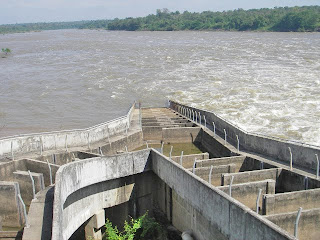This movie doesn't have anything to do with the decentralized energy stuff from yesterday at the conference. I took this when I was actually at the Hou Sahong channel and I just finally uploaded it. This is just one narrow channel of many in this area, where the Mekong stretches to 14 km wide. Shows ya how strong and how much water flows through here.
So the energy workshop proved to be very interesting and brought to my attention a different angle on the issue at hand, electrification of rural Cambodia and how to do it right from the start.
Cambodia and Laos are in very unique positions right now because they cut up their land for energy yet. I mean, they haven't dammed up the most important parts of the Mekong, they haven't cut their entire forests (although they are logging rampantly), they haven't put transmission lines all over their land. What if they were able to skip the damaging steps that a central electricity program takes (entities owned by public or private firms) and start with a sustainable and local form of electricity?
Rural electrification is very expensive (and 40% of the cost is transmission) unless it could be done in a de-central way, that is through things like solar panels, biomass into combustible gas (rice husks, wood chips, cashew and peanut shells), and methane pig farms.
I met Carl Middleton, Mekong rep for International Rivers. He told me that fisherman up in the Khone Falls area just accidentally caught a giant catfish, 200 kg, in one of their traps! It's endangered and they only catch these things like every two years. It is illegal to catch them, and Carl said the government came in immediately and took the fish carcass away. I am trying to find more on this, and I think Ian Baird will be able to tell me more today.
Also present at the meeting was Kamworks, a solar panel light companies with "moonlights," small, durable, inexpensive lanterns that run on solar energy and cost about
There is a micro hydro power dam in Chang Mai, Thailand, that produces 40 kw and profits $13,00 yearly selling energy back to Thailand. A village in Poi Et burns rice husks and uses the combustible gas to make electricity, and sells its energy back to Thailand.
 Pig farms in Thailand put manure in a digester and use the methane, which also keeps clean their water supply and village. The laws that Thailand has to make this possible just aren't in place yet in Cambodia or Laos, and that is what these NGOs are trying to get moving.
Pig farms in Thailand put manure in a digester and use the methane, which also keeps clean their water supply and village. The laws that Thailand has to make this possible just aren't in place yet in Cambodia or Laos, and that is what these NGOs are trying to get moving.Bangkok Airport powers itself completely because it cannot rely on the Bangkok
s grid system. It runs off a 45 mw gas fire cogeneration plant, and it uses all of the water heated up to produce air conditioning for the entire place.
Mr. Witoon Permpongsacharoen from Mekong Energy and Ecology Network spoke about decentralizing energy in Cambodia and also about how to forecast energy demands. He said Thailand over forecasts their demands, and this disrupts production efforts in Cambodia and Laos, where they try to produce and sell to Thailand and in turn ruin some of their own resources (ie Hou Sahong channel).
 He also spoke of the Pak Mun Dam (136 MW) on the Mun River in Thailand, a shining example of the damage a major hydroelectric dam can do to a region. Built in 94 by the Electricity Generating Authority of Thailand with US$24 million in financing from the World Bank, the dam has blocked fish migration and hurt the livelihoods of 20,000 people. The fish ladder, promoted by the World Bank’s fisheries experts as a mitigation measure, has proved useless because the species in the Mekong don't respond to it like jumping salmon do, in the US, for example.
He also spoke of the Pak Mun Dam (136 MW) on the Mun River in Thailand, a shining example of the damage a major hydroelectric dam can do to a region. Built in 94 by the Electricity Generating Authority of Thailand with US$24 million in financing from the World Bank, the dam has blocked fish migration and hurt the livelihoods of 20,000 people. The fish ladder, promoted by the World Bank’s fisheries experts as a mitigation measure, has proved useless because the species in the Mekong don't respond to it like jumping salmon do, in the US, for example.(picture from International Rivers)
Carl Middleton, in his presentation, asked the audience, in reference to dams, "Why are we still using technology that is over 100 years old? It doesn't make sense and it undermines other forms of development. We can generate electricity close to where the need is and save money. In Cambodia, we still have the choice to choose decentralized energy. Of course all sources of power should be subject to community approval."

No comments:
Post a Comment